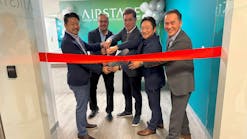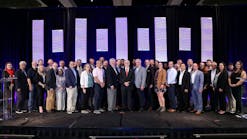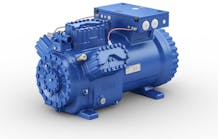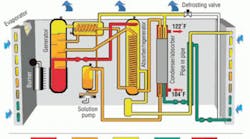Condensing gas-fired hydronic boilers have become increasingly popular in commercial heating applications during the last 20 years. Several models of condensing boilers now have thermal efficiencies approaching 100 percent at low firing rates and return-water temperatures. However, the 100-percent level remains the fundamental efficiency limit for hydronic heating systems in the commercial-buildings sector.
Gas-fired absorption heat pumps can be used in commercial heating applications and achieve thermal-efficiency levels as high as 145 percent by drawing heat from renewable energy resources, such as the ground, water, or ambient air. Absorption heat pumps use natural ammonia-water refrigerant and offer energy and carbon-dioxide- (CO2-) emissions savings of up to 30 percent or more, compared with condensing boilers.
Absorption heat pumps have gained significant market share in Europe and recently were introduced to North America. They offer new opportunities to significantly improve energy efficiency in schools/universities, hospitals, office buildings, and manufacturing facilities.
The Absorption Thermodynamic Cycle
The absorption thermodynamic cycle incorporates several stages of temperature and pressure change that enable ammonia-water working fluid to absorb heat from a gas-fired burner, ambient air, or geothermal heat sources and transfer it to a hydronic distribution loop.
- The first stage of the absorption cycle includes heating the working fluid in a gas-fired-generator component. The ammonia portion of the working fluid boils into vapor under high pressure and passes through a partially cooled rectifier to remove residual water.
- During the second stage of the cycle, the ammonia vapor enters the condenser, where it is changed back into a liquid state while transferring heat to the hydronic loop.
- During the third stage, the ammonia liquid passes through a throttling device and undergoes a substantial pressure reduction.
- During the fourth stage, the low-pressure liquid ammonia enters the evaporator component and changes back to vapor as it absorbs heat from the air or geothermal/water heat source.
- During the fifth stage, the ammonia vapor continues to the absorber component, which contains a weaker solution (i.e., a lower ammonia concentration) of the original ammonia-water working fluid, and is absorbed into the working fluid through an exothermic reaction that increases the temperature of the working fluid and releases additional heat into the hydronic loop.
- During the sixth stage, the liquid-solution pump increases the pressure of the ammonia-water working fluid to meet the high pressure of the generator component. The absorption cycle then repeats itself, beginning with the first stage.
Certain analogies between the absorption cycle and the compressor-driven Rankine cycle commonly used in electrically driven heat-pump systems exist. The liquid-solution pump and gas-fired-generator components perform the same function as the compressor in the Rankine cycle by producing high-pressure ammonia vapor. Also, the absorber component draws the ammonia vapor from the evaporator component and is analogous to the suction side of a refrigerant compressor. Finally, the throttling device and evaporator component in the absorption cycle perform the same pressure-reduction and heat-absorption functions as in the Rankine cycle.
For each unit of fuel used in the gas-fired-generator component, 0.85 units of heat are transferred directly through the condenser component into the hydronic distribution loop. Additionally, the ammonia refrigerant draws up to 0.60 units of low-temperature heat from the ambient air or geothermal/water source while in the evaporator component and transfers it to the hydronic distribution loop during its absorption into the weak ammonia-water solution located in the absorber component. Therefore, a total of 1.45 units of heat can be transferred into the hydronic loop for each unit of fuel input, thus achieving the described overall thermal efficiency of 145 percent.
Figure 1 shows heating-performance characteristics of representative air-source and geothermal/ water-source absorption heat pumps. Air-absorption heat pumps exhibit lower efficiencies at low outdoor temperatures, but still maintain significantly higher efficiencies than condensing boilers under nearly all ambient-temperature conditions. Geothermal absorption heat pumps tend to show relatively constant energy performance vs. outdoor temperature.
Absorption heat pumps operate most efficiently when the heat source is at least moderately warm (e.g., geothermal) or when the heating supply temperature is relatively low (e.g., radiant-heat or water-loop heat-pump applications). Low-temperature (140˚F or less) thermal-distribution systems enable absorption heat pumps to achieve the greatest energy savings. Designers should size thermal-distribution components (e.g., baseboard/convector units, heating coils for ventilation/supply air, etc.) to ensure that supply- and return-water temperatures are as low as possible.
Integration With Hybrid Systems
Absorption heat pumps can be used as lead components within hybrid heat-pump-plus-boiler systems to cost-effectively maximize seasonal energy performance. A heat pump is the first component to respond to a call for heat by a building control system. Boiler components operate only when a heating load exceeds the capacity of the absorption heat pump.
Figure 2 shows geothermal/water-source and air-source versions of the hybrid absorption-heat-pump-plus-boiler system. System piping should be configured to allow cool return water to flow to absorption heat pumps when possible to maximize efficiency. Air-source versions of absorption heat pumps should be located either outdoors or in a mechanical room with ample exposure to ambient air.
Absorption-heat-pump-plus-boiler systems should include smart controls to optimize performance under part-load and design-load conditions. Improved reliability and reduced installation costs also can be achieved through the factory design and manufacturing of fully assembled "plug-and-play" absorption-heat-pump-plus-boiler systems.
Based on typical load profiles and temperature bin-hour data for many commercial heating applications in northern climate zones, most operating hours occur under part-load conditions.
Even if the absorption-heat-pump portion of a hybrid system is sized for only 25 percent of the peak heating load, it will provide more than half of the total heating-system output because it will operate throughout nearly the entire heating season. On the other hand, if the heat-pump portion is sized for 50 percent of the peak load, it can provide more than 90 percent of the total heating-system output.
An absorption-heat-pump-plus-boiler system with equal proportions of heat-pump and boiler capacity can achieve essentially the same seasonal efficiency as a heat-pump-only system. Depending on building-owner preferences, the heating capacity of the absorption-heat-pump portion of a hybrid system usually will be within 25 to 50 percent of total hybrid-system capacity.
Table 1 includes calculations of heating loads and system performance for a hybrid air-source absorption-heat-pump-plus-boiler system with a total heating capacity of 2 MMBtuh. The system is intended to provide supplemental heat to maintain a minimum temperature of 60˚F in the circulating water loop of a water-source (run-around-type) heat-pump system. The absorption-heat-pump and boiler components each have a capacity of 1 MMBtuh. Table 1 compares a hybrid system with a traditional condensing-boiler system that has a capacity of 2 MMBtuh. For evaluation purposes, the design heating load of the example commercial building also is 2 MMBtuh.
Table 1 incorporates bin-hour weather data, calculated heating loads for each temperature bin, and respective heating outputs for the absorption and boiler components. The table shows that sizing an absorption heat pump for 50 percent of a hybrid system can achieve substantial energy savings on a seasonal basis. Although the table utilizes Chicago weather data, many other geographic locations would show similar results. Just over 90 percent of a hybrid system’s total heating output is provided by the absorption-heat-pump component.
The design choices and calculations in the table can be adapted to evaluate other sizing options for a hybrid system. For example, the relative size of the heat-pump component can be increased or decreased to meet the desired criteria for energy and economic performance. Heat-pump-efficiency data also could be modified to reflect geothermal vs. air-source performance.
The air-source version of the hybrid absorption-heat-pump-plus-boiler system achieves about 24-percent energy savings in water-loop heat-pump applications by increasing seasonal thermal efficiency from 95 percent (for traditional condensing boilers) to 125 percent. An air-source hybrid system also can increase the seasonal efficiency of conventional hydronic (baseboard/convector) heating from 89 percent to 105 percent, depending on distribution temperature.
Hybrid Systems in Geothermal Applications
Geothermal electrically driven heat-pump systems have gained market interest because of their ability to use ground-coupled heat exchangers to provide efficient heating and cooling in commercial buildings. Geothermal-heat-pump systems are effective in reducing electricity consumption and peak electricity demand for summer cooling, but incur substantial energy costs for heating in northern climates. Additionally, the capital costs of geothermal borewell fields and ground loops have presented a considerable barrier to market acceptance.
When used in geothermal mode, absorption heat pumps offer an innovative design alternative to traditional geothermal electrically driven heat pumps. The coefficient of performance (COP) of a geothermal electrically driven heat pump should be multiplied by the average 30-percent efficiency garnered by fuel-fired power generation to determine a primary-energy-utilization factor (i.e., the ratio of heat-pump thermal output to power-generation fuel input), which often is similar to that of condensing boiler systems.
Absorption heat pumps can achieve thermal efficiencies of 120 to almost 150 percent in several types of geothermal heating applications. The primary-energy performance of a geothermal absorption heat pump can be equivalent to that of an electrically driven geothermal heat pump with a heating COP of approximately 4 or 5 and, therefore, will equal or exceed the performance of most electrically driven systems under real-world northern-climate conditions.
An absorption heat pump can reduce CO2 emissions by about 25 to 60 percent compared with an electrically driven heat pump using electricity produced by coal-fired power generation, which provides more than 60 percent of the electricity produced in the United States.
Additionally, a gas-fired absorption heat pump can achieve size and capital-cost reductions of 30 to 40 percent for geothermal borewell fields/ground loops. When an absorption heat pump is in heating mode, approximately 60 percent of the total heat output is derived from fuel combustion, while approximately 40 percent is drawn from the geothermal source. A 1-million-Btuh geothermal gas-fired absorption heat pump in heating mode procures approximately 400,000 Btuh of heat extraction from the geothermal borewell field/ground loop. Comparatively, a traditional electric geothermal-heat-pump system derives approximately 70 percent of its total heat output from the geothermal field, based on characteristics of the Rankine thermodynamic cycle. Thus, the electrically driven heat pump would require a geothermal borewell field/ground loop with approximately 700,000 Btuh of heat-extraction capacity.
Geothermal-borewell-field/ground-loop expenses typically range from $2,000 to $5,000 per ton of capacity, depending on location, which translates to substantial capital-cost savings for prospective geothermal heat-pump users.
Energy Savings in Commercial Heating Applications Table 2 shows representative energy savings associated with four hybrid absorption-heat-pump-plus-boiler systems. Each representative system incorporates the same 50/50 relative absorption-heat-pump/ boiler-size ratio used in the analyses described previously.
The energy savings noted in Table 2 are relative to traditional condensing-boiler systems with seasonal energy efficiencies that depend on average supply-/return-water-temperature combinations and typically range from 88 to 90 percent for hydronic applications and 90 to 95 percent for water-loop-heat-pump applications.
Cooling Options
Gas-fired absorption heat pumps also can provide cooling and be used in combination with electrically driven chillers to help meet peak air-conditioning loads. Electricity-cost savings can be significant, especially where utility-rate structures include high demand charges, real-time pricing, or ratchet clauses that include continuing monthly charges for one-time peak electrical-demand occurrences.
Reducing size requirements for electric chillers and using a three-way absorption-heat-pump/boiler/electric-chiller heating-and-cooling-system design can help reduce the net capital cost of absorption-heat-pump systems. Similarly, combining gas-fired absorption heat pumps (operating in air-source mode during summer) with geothermal electrically driven heat pumps can substantially reduce the size and capital costs of geothermal fields.
A hybrid absorption-heat-pump/boiler/electric-chiller system can achieve essentially the same cooling efficiency as an all-electric system—whether air-source or geothermal—because the electric chiller can operate in base-load mode and provide more than 90 percent of the total cooling output over the course of the cooling season.
Gas-fired absorption heat pumps also can produce simultaneous heating and cooling outputs. Commercial-building applications that require concurrent heating for perimeter zones and cooling for interior office zones or computer systems or that have auxiliary heating loads (e.g., domestic hot water or swimming pools) can be served by absorption heat pumps during the cooling season with especially favorable energy performance.
Conclusion
Able to draw heat from renewable energy resources such as the ground, water, or air, hybrid absorption-heat-pump-plus-boiler systems offer seasonal efficiency levels as high as 145 percent and energy savings of up to 30 percent or more for heating schools/universities, hospitals, office buildings, and manufacturing facilities. Based on temperature bin-hour data and typical load profiles for many commercial buildings, most operating hours occur under part-load conditions. Therefore, even if the absorption-heat-pump component of a hybrid system is sized for only 50 percent of the peak heating load, it can provide more than 90 percent of the total thermal output during the heating season in most applications.
Absorption heat pumps also provide increased flexibility by enabling building owners to use natural gas instead of electricity to achieve high efficiency in heating mode and meet peak cooling loads. Absorption heat pumps also can achieve substantial capital-cost savings for geothermal applications because they can operate with 30- to 40-percent smaller borewell-field/ground-loop components.
James Pettiford is the director of engineering for Fulton Heating Solutions' new-product development group and has 15 years of experience in the design and development of advanced commercial and industrial boilers. The commercial-heating-product manager for Fulton Heating Solutions, Erin Sperry is responsible for modular hydronic heating products and has extensive experience in applications engineering for activities surrounding the design and installation of commercial heating systems. The chief engineer for Fulton Thermal Corp., Melissa Wadkinson has 16 years of experience and is involved in the design and application of commercial and industrial boilers. A product manager at Robur SpA, Fabio Spreafico is responsible for gas-absorption products (heat pumps and chillers) for North America.









